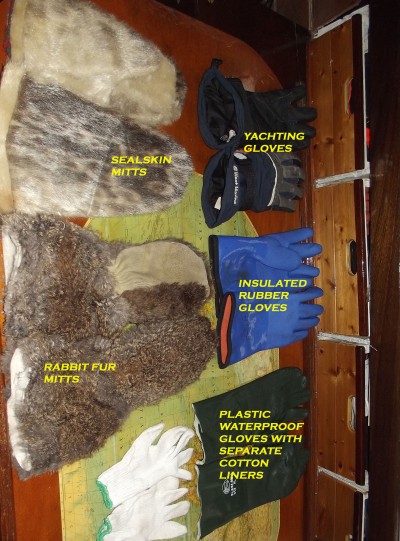 I used a variety of gloves and mitts this year in the NW Passage. This is what I found to be useful for cold-weather sailing. As a general rule, insulated gloves of various kinds work well in temperatures 8C/45F and above. For colder temperatures, mitts are the only things to keep hands warm. Note that I don’t pull on ropes with any of these gloves or mitts–I don’t think any of them will last long if used for pulling hard on ropes with. As most of ones time is not spent pulling on ropes, it isn’t much of a problem to remove gloves/mitts to pull on ropes (reef/tack/gybe/etc), then put the gloves/mitts back on to warm back up. Sealskin Mitts with Felt Lining (top left): Not generally found in stores, I got these in the Northwest Territories many years ago. One of the mitts is now missing the (removable) felt liner–otherwise, these would have been the warmest mitts I had. Excellent for keeping the hands warm (especially with a spare set of liners so one can be drying below while the other is in use), and very easy to get on and off. Too hot to be worn above 10C/50F. Rabbit Fur Mitts with Polyester Insulation (middle left): These are made in China, and sold in Canada (and probably USA) at outdoor equipment stores for about $30. They are the warmest mitts I had aboard. Even when moderately wet they were still warm (though when it rained a lot, I switched to the blue insulated rubber gloves). Too hot to be worn above 10C/50F.Insulated Yachting Gloves (top right): I got the West Marine insulated gloves several years ago and never used them until this year. They work well in mild temperatures, and are a bit warmer than the insulated rubber gloves when it isn’t really wet. Quite comfortable to steer with. Warm down to about 8C/45F. Blue Insulated Rubber Gloves (middle right): I got a pair of these in Rimouski, Quebec for about $10. I only bought one pair because I wrongly figured I could buy another pair along the way at any fishing supply store. It wasn’t until Alaska that I found another pair. Excellent in wet weather, and warm to about 8C/45F. Loose and stiff enough to be easy to take on and off. They take a long time to dry the insulation out, though, so best to have more than one pair. Green Plastic Gloves with Separate Cotton Liners (bottom): In Cartwright, Labrador, I was told all the fishermen had switched to using waterproof gloves with separate liners, that way, when the liners got wet, they just changed liners. Though I’m sure it worked for the fishermen, I didn’t find this combination all that useful. This combination did work, but it takes a while to take off both an outer and inner glove, so didn’t work all that well with my habit of taking off gloves/mitts before pulling on ropes. If I only took off the outer glove (which was easy), then I’d wet the cotton liners handling the wet ropes (and wet cotton has no insulation value). This system would work better if one had enough of the outer gloves aboard that one could just wear the gloves while handling ropes, let the gloves wear out and replace the gloves as they wore out (buying replacements as you go along is not practical in the NW Passage, where you can’t rely on being able to buy anything, so if you don’t have it with you, you may need to do without it).
I used a variety of gloves and mitts this year in the NW Passage. This is what I found to be useful for cold-weather sailing. As a general rule, insulated gloves of various kinds work well in temperatures 8C/45F and above. For colder temperatures, mitts are the only things to keep hands warm. Note that I don’t pull on ropes with any of these gloves or mitts–I don’t think any of them will last long if used for pulling hard on ropes with. As most of ones time is not spent pulling on ropes, it isn’t much of a problem to remove gloves/mitts to pull on ropes (reef/tack/gybe/etc), then put the gloves/mitts back on to warm back up. Sealskin Mitts with Felt Lining (top left): Not generally found in stores, I got these in the Northwest Territories many years ago. One of the mitts is now missing the (removable) felt liner–otherwise, these would have been the warmest mitts I had. Excellent for keeping the hands warm (especially with a spare set of liners so one can be drying below while the other is in use), and very easy to get on and off. Too hot to be worn above 10C/50F. Rabbit Fur Mitts with Polyester Insulation (middle left): These are made in China, and sold in Canada (and probably USA) at outdoor equipment stores for about $30. They are the warmest mitts I had aboard. Even when moderately wet they were still warm (though when it rained a lot, I switched to the blue insulated rubber gloves). Too hot to be worn above 10C/50F.Insulated Yachting Gloves (top right): I got the West Marine insulated gloves several years ago and never used them until this year. They work well in mild temperatures, and are a bit warmer than the insulated rubber gloves when it isn’t really wet. Quite comfortable to steer with. Warm down to about 8C/45F. Blue Insulated Rubber Gloves (middle right): I got a pair of these in Rimouski, Quebec for about $10. I only bought one pair because I wrongly figured I could buy another pair along the way at any fishing supply store. It wasn’t until Alaska that I found another pair. Excellent in wet weather, and warm to about 8C/45F. Loose and stiff enough to be easy to take on and off. They take a long time to dry the insulation out, though, so best to have more than one pair. Green Plastic Gloves with Separate Cotton Liners (bottom): In Cartwright, Labrador, I was told all the fishermen had switched to using waterproof gloves with separate liners, that way, when the liners got wet, they just changed liners. Though I’m sure it worked for the fishermen, I didn’t find this combination all that useful. This combination did work, but it takes a while to take off both an outer and inner glove, so didn’t work all that well with my habit of taking off gloves/mitts before pulling on ropes. If I only took off the outer glove (which was easy), then I’d wet the cotton liners handling the wet ropes (and wet cotton has no insulation value). This system would work better if one had enough of the outer gloves aboard that one could just wear the gloves while handling ropes, let the gloves wear out and replace the gloves as they wore out (buying replacements as you go along is not practical in the NW Passage, where you can’t rely on being able to buy anything, so if you don’t have it with you, you may need to do without it).
Monthly Archives: October 2011
Shaggy Sails
Yakutat Bay, Alaska
 Imvubu sailing ahead of Issuma (picture taken Oct 17). The edges of the sails that are set on Issuma have tattered cloth hanging off them. The tattered cloth is the remnants of the ultraviolet protection cloth that is put on roller furled sails (so the sails are shielded from UV when they are furled). The cloth that is typically used for UV-protection on sails (sunbrella) has poor resistance to abrasion. The cloth has been abraded by rubbing against rigging wires when tacking. While the UV-protection cloth does need to be replaced (preferably with something more durable), one of the advantages of sailing in an area where it is cloudy and rainy most of the time is that there is hardly any UV around to damage things, so this repair can wait :). I’m not entirely sure how I’m going to fix the UV-protection on these sails–I’d like to find a more durable cloth (maybe in black so it definitely blocks UV?) and probably glue it on (no stitches to get abraded away).
Imvubu sailing ahead of Issuma (picture taken Oct 17). The edges of the sails that are set on Issuma have tattered cloth hanging off them. The tattered cloth is the remnants of the ultraviolet protection cloth that is put on roller furled sails (so the sails are shielded from UV when they are furled). The cloth that is typically used for UV-protection on sails (sunbrella) has poor resistance to abrasion. The cloth has been abraded by rubbing against rigging wires when tacking. While the UV-protection cloth does need to be replaced (preferably with something more durable), one of the advantages of sailing in an area where it is cloudy and rainy most of the time is that there is hardly any UV around to damage things, so this repair can wait :). I’m not entirely sure how I’m going to fix the UV-protection on these sails–I’d like to find a more durable cloth (maybe in black so it definitely blocks UV?) and probably glue it on (no stitches to get abraded away).
Bergy Bit
Yakutat Bay, Alaska
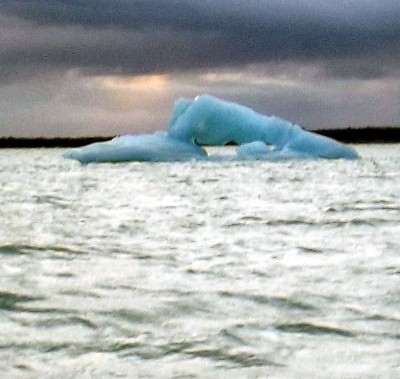 Bergy bit with a hole big enough to kayak thru (except for the extreme danger that doing so would present if the ice rolled over).
Bergy bit with a hole big enough to kayak thru (except for the extreme danger that doing so would present if the ice rolled over).
Disenchantment Bay
Yakutat Bay, Alaska
 In 1792, Alessandro Malaspina, an Italian nobleman and Spanish Naval officer, was looking for the Northwest Passage for the King of Spain. Sailing up Yakutat Bay until stopped by the ice from the glaciers, he named the NE part of Yakutat Bay Puerto del Desengano (Disenchantment Bay).
In 1792, Alessandro Malaspina, an Italian nobleman and Spanish Naval officer, was looking for the Northwest Passage for the King of Spain. Sailing up Yakutat Bay until stopped by the ice from the glaciers, he named the NE part of Yakutat Bay Puerto del Desengano (Disenchantment Bay).
Bergy Bit
Yakutat Bay, Alaska
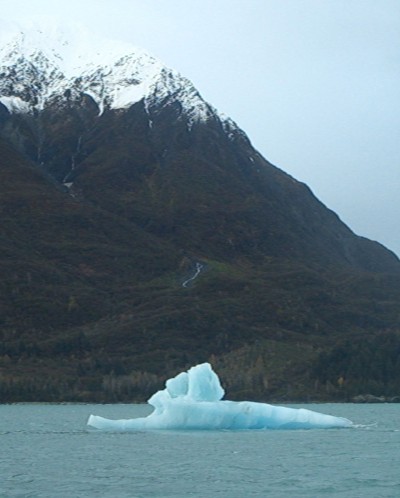 Bergy bit from Hubbard Glacier.
Bergy bit from Hubbard Glacier.
Growlers
Yak
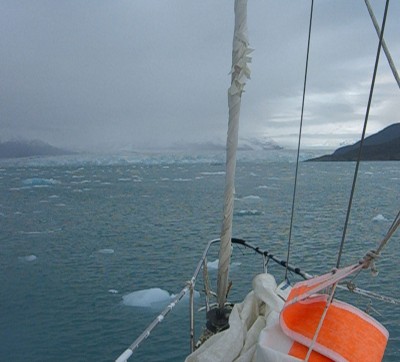 Growlers in front of the Hubbard Glacier.
Growlers in front of the Hubbard Glacier.
Hubbard Glacier
Yakutat Bay, Alaska
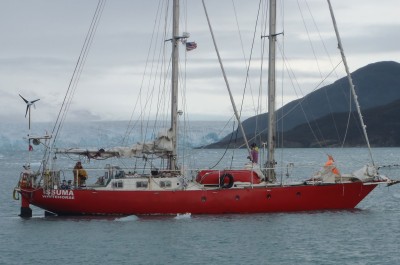 The Hubbard Glacier is the longest tidewater glacier in Alaska. We sailed and then motored up Yakutat Bay to have a look at it.
The Hubbard Glacier is the longest tidewater glacier in Alaska. We sailed and then motored up Yakutat Bay to have a look at it.
Sailing in Yakutat Bay
Yakutat Bay, Alaska
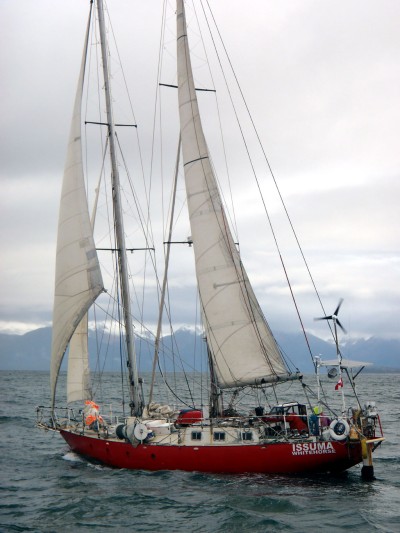 Yakutat Bay is beautiful. As could be expected for Alaska in October, it rains a lot. The Facnor furler was giving problems (it is fixed now), so we weren’t using the main staysail.
Yakutat Bay is beautiful. As could be expected for Alaska in October, it rains a lot. The Facnor furler was giving problems (it is fixed now), so we weren’t using the main staysail.
Sailing in Yakutat Bay
Yakutat Bay, Alaska
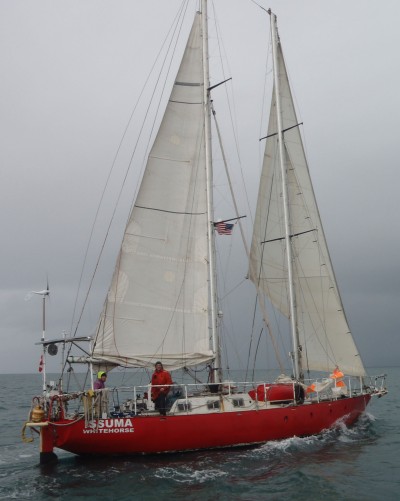 We are waiting in Yakutat for a change in the weather. My friend Ralf on Imvubu (www.yachtimvubu.com) has been doing the same. We went sailing up Yakutat Bay to have a look at the glaciers (the weather in Yakutat Bay is often much different than the weather outside), so Ralf took this picture from his boat.
We are waiting in Yakutat for a change in the weather. My friend Ralf on Imvubu (www.yachtimvubu.com) has been doing the same. We went sailing up Yakutat Bay to have a look at the glaciers (the weather in Yakutat Bay is often much different than the weather outside), so Ralf took this picture from his boat.
Yakutat
Yakutat, Alaska
 Being a very rural place (population about 500), there is lots of wildlife around Yakutat. The pipeline behind the deer is used to pump fuel from fuel barges to the fuel storage tanks.
Being a very rural place (population about 500), there is lots of wildlife around Yakutat. The pipeline behind the deer is used to pump fuel from fuel barges to the fuel storage tanks.